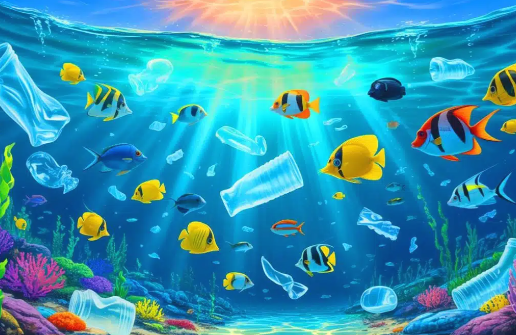IN BRIEF
- 🌊 Plastic pollution continues to persist in the oceans, even if emissions were to stop immediately.
- 🔬 Microplastics fragment and circulate between the ocean’s surface and its depths.
- 🌿 Marine snow plays a key role in transporting microplastics toward the seabed.
- 🛠️ Global action is urgently needed to protect marine ecosystems and slow down this pollution.
Plastic pollution continues to persist in the oceans, posing a lasting threat to marine ecosystems and calling for urgent global action. Even if plastic waste were to stop entering the oceans today, residual plastics would persist for decades — even centuries.
This alarming reality is highlighted by a recent British study that models the fate of polymers in marine environments. Researchers from Queen Mary University of London have published a simulation revealing the slow journey of plastics through the ocean. Their findings, published in Philosophical Transactions of the Royal Society A, describe how floating debris gradually fragments before sinking into the depths. This study is the latest in a series dedicated to understanding the long-term dynamics of microplastics.
The Slow Degradation of Polymers
The model focuses on the behavior of a 10-millimeter polyethylene fragment, representative of common plastic pollution. Once in contact with seawater, degradation begins under the combined effects of UV radiation, salinity, and wave motion. This slow erosion gradually produces microparticles, with the fragment losing around 0.45% of its mass each month. These microplastics then enter a complex vertical transport cycle.
Small particles bind to marine snow — the continuous fall of organic matter toward the ocean floor. However, the process is far from linear: aggregates can break apart, releasing fragments that rise back to the surface. According to the study, even after 30 years, a large portion of the material remains in the form of microplastics.
Dr. Nan Wu emphasizes that this extremely slow degradation creates a persistent source of pollution, continuously fueling the contamination of marine ecosystems.
The Role of Marine Snow
Marine snow plays a crucial role in transporting organic matter to the ocean depths. The study reveals that it preferentially captures microplastics smaller than 75 micrometers. This process depends on the size and density of the fragments, creating a sophisticated sorting mechanism across different ocean layers. Marine snow aggregates continuously form and disintegrate, causing microplastics to move back and forth between the surface and the deep sea.
Over a century, about 90% of the initial plastic mass becomes trapped in deep-sea sediments. However, the remaining 10% continues to float at the surface, forming an active pollution reservoir for future decades. Professor Kate Spencer highlights the intergenerational nature of this pollution. This phenomenon could disrupt the oceanic biological pump and biogeochemical cycles, undermining the oceans’ role as a carbon sink.
Impact on Marine Ecosystems
Microplastics in the oceans have direct consequences for marine ecosystems. When animals ingest these particles, they can suffer from digestive blockages, malnutrition, or even death. Moreover, these particles can contaminate food chains, reaching top predators — including humans.
Microplastics also affect reproduction and growth in certain species. By disrupting natural habitats, plastics alter the ecological balance of marine environments. Such disturbances can lead to reduced biodiversity and ecological imbalance. Research underscores the urgency of reducing plastic discharges to protect marine life.
Solutions to Reduce Plastic Pollution
To address this issue, several strategies can help reduce ocean plastic pollution:
- Cutting down production and consumption of single-use plastics is essential.
- Promoting durable and recyclable materials can help limit waste.
- Public policies play a vital role — enforcing strict regulations on plastic production and waste management is key.
- Raising public awareness about the consequences of plastic pollution can encourage more sustainable behavior.
- Investing in research to develop technologies for ocean cleanup and plastic degradation is crucial.
Though complex, these initiatives are necessary to preserve the oceans for future generations.
A Global Challenge
Plastic pollution in the oceans is a complex and intergenerational problem. Recent studies highlight the scale of the challenge in protecting marine ecosystems. The question remains:
👉 What concrete global actions can we take to slow this pollution and safeguard our planet?
Source: innovant




